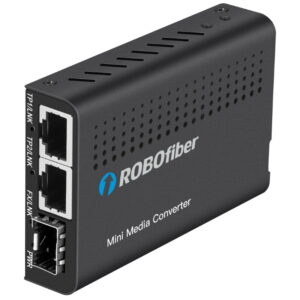As demand for faster, more reliable data transmission continues to rise, fiber optic networking has become the gold standard for high-speed internet and IP-based control. But deploying fiber requires more than just the cables — a range of electronics are essential to translate, switch, and transmit data across the network. This article explores the electronics commonly used in residential and commercial fiber-based networks, as well as the connectivity components required to integrate them.
Future Ready Solutions offers the solutions described in this article. Product information is available from the links below:
- Fiber Media Converters
- Fiber Network Switches
- Fiber Transceiver Modules
- Fiber Enclosures
- Outdoor Equipment Enclosures
Media Converters: Bridging Fiber and Copper
Media converters are devices that convert signals between different media types — most commonly between fiber optic and twisted pair. They allow existing copper-based networks to integrate with fiber cabling without the need to replace the entire infrastructure.
Media converters are essential because network electronics still commonly feature RJ45 ports and they’re bound by the limitations of copper-based networking, such as 100m / 330ft maximum transmission distances, 10G bandwidth, and susceptibility to lightning, static electricity, power surges, and RF and EM interference. Fiber does not have these limitations and media converters effectively bridge the copper-to-fiber gap.
Depending on the model, media converters support up to 10G network traffic and even inject PoE+ power for connected electronics.
Media Converters: Bridging Other Signal Formats
Media converters are also used to adapt other signal formats to fiber, including serial RS232, RS485, RS422, and even HDMI, USB, and IR. Fiber is an ideal medium for the high-bandwidth needs of HDMI and USB, and we’re seeing increased products from LightSpeed Technologies and AVPro Edge that address long-distance signal-over-fiber extension.
Media converters can even be used to adapt one type of fiber to a different type of fiber. The ROBOfiber LFC-1000-SS features two transceiver ports that convert multimode fiber to single mode fiber and vice versa.
Network Switches: Managing Fiber Connections
Network switches are central hubs that direct data traffic between devices on a local area network (LAN). Fiber-capable switches include ports that accept fiber transceivers (SFP/SFP+/QSFP/etc.), allowing them to handle fiber links alongside traditional copper RJ45 ports.
Fiber-capable network switches are increasingly used in residential and commercial applications for high-speed networking, building-to-building transmission, and AV over IP.
ROBOfiber offers a variety of hardened fiber-capable switches designed for indoor and outdoor integrations (provided a suitable weather-rated enclosure is used).
Transceiver Modules: Enabling Fiber Communication
Transceiver modules (commonly known as SFP modules) are small, hot-swappable devices that plug into network equipment such as switches and media converters. They convert electrical signals to optical signals and vice versa for transmission over fiber optic cables.
Transceiver modules are typically specific to a type of fiber (such as single mode or multimode) and a network speed (such as SFP+ or QSFP), and manufactures commonly leverage empty transceiver ports on electronics to allow a greater range of compatibility in the field.
Most transceivers require a duplex (two strand) fiber connection; however, BiDi transceivers only require a single fiber strand for bi-directional network communication.
Fiber optic networking requires more than just high-quality cables — it depends on a range of specialized electronics to function efficiently. Media converters provide flexibility and backward compatibility. Network switches serve as the nerve centers for directing traffic. Transceiver modules enable fast, precise communication over fiber lines while offering the flexibility to adapt electronics in-the-field.
Understanding how each of these components fits into a fiber-based network helps ensure reliable, high-speed connections for today’s bandwidth-intensive applications.
All of these solutions are available on the Future Ready Solutions website or by contacting us at info@futurereadysolutions.com.
